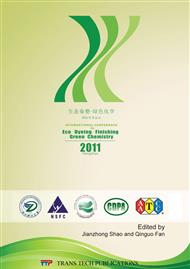p.179
p.183
p.187
p.192
p.200
p.207
p.212
p.217
p.222
Technology and Mechanism of Redox Degumming on Apocynum
Abstract:
In order to discuss the mechanism of redoxdegumming process on apocynum, the pH value of redoxdegumming solution has been detected firstly in the test. Secondly, free radicals of redox itself and apocynum in dealing with the system have been detected by electron paramagnetic resonance spectra (ESR). These test results showed the redoxtreatment solution reacted and produced acidic substances constantly to maintain a stable pH value, The acidic substances and stable pH value could promote swelling and dissolving of pectic substances on the surface of apocynumbark bark. At the same time, free radicals have been stimulated from apocynum constituents by redox, and the activation energy of noncellulosics of apocynum reduced. Besides, the performances of apocynum fibers produced by the redoxdegumming technology have been measured in the test. The results showed that the apocynum fibers redoxare superior to that produced by the traditional degumming process in terms of finished products rate of fiber, fiber length, single fiber strength, etc. Compared to the traditional degumming process, the redoxdegumming process of apocynum can shorten the alkali scouring time greatly, which can save energy used in the production.
Info:
Periodical:
Pages:
200-206
Citation:
Online since:
January 2012
Authors:
Keywords:
Price:
Сopyright:
© 2012 Trans Tech Publications Ltd. All Rights Reserved
Share:
Citation:


